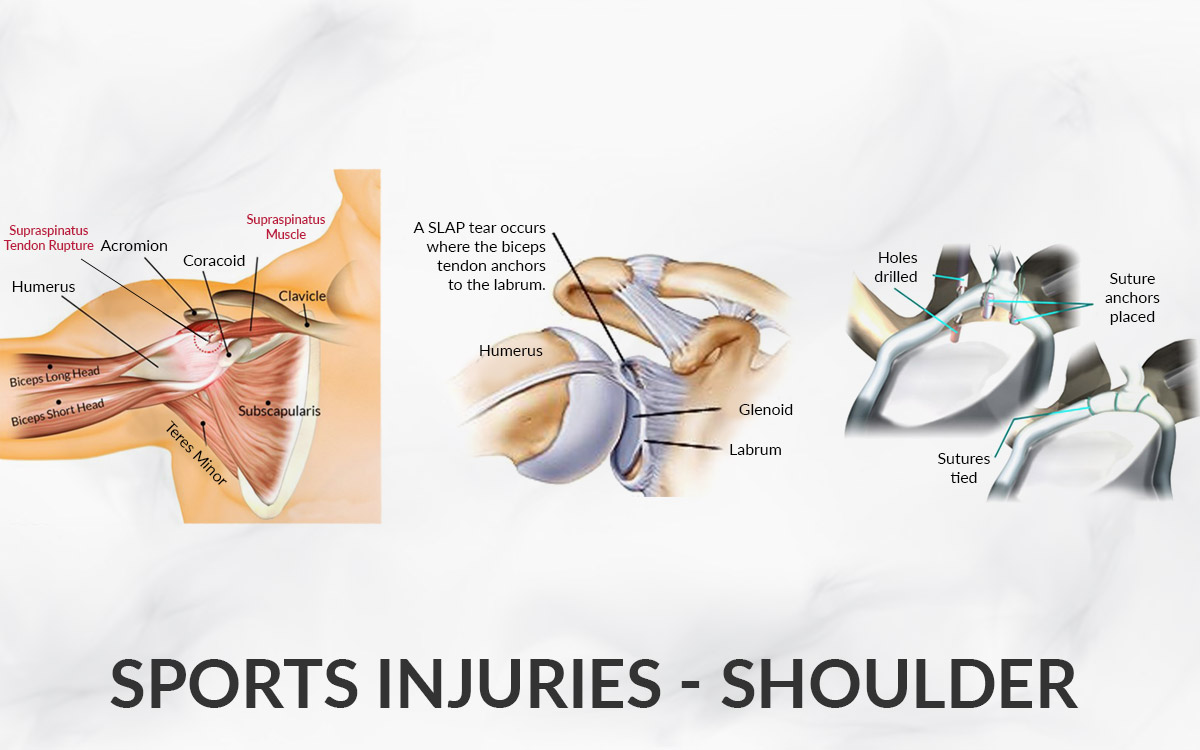
Summary
Causes
- Fall on the arm
- Repetition of same arm motion
- Throwing with excessive force
Common Sports injuries of Shoulder
- Rotator Cuff Tear
- Acromioclavicular Joint Separation (ACJ Separation)
- SLAP Tear (Superior Labrum Anterior and Posterior)
- Dislocated Shoulder
- Shoulder Tendonitis
- Shoulder Bursitis
- Pectoralis Major Rupture
Shoulder Anatomy
Shoulder joint is made up of three bones; clavicle (collar bone), scapula (shoulder blade), and the humerus (upper arm bone). Injury to these bones and its surrounding ligaments and the muscles is most often sustained during sports with repetitive overhead motion such as pitching in a baseball or overhead throws. The highest shoulder injury in sports occurs in football followed by wrestling and baseball for boys and in softball and volleyball for girls.
The shoulder is a complex joint connecting the arm to the rest of the body and it is this joint that has the greatest range of motion in the body. In addition to shoulder’s flexibility and range of motion, it is both capable of lifting heavy loads and quick snapping motions like throwing a football or a basketball. However, due to the flexibility of the joint, it is also prone to injury when we fall or throw something a little too hard or repeat the same movement too many times.
Here’s a list of some common shoulder injuries which can happen during sports:
Rotator Cuff Tear
Rotator cuff tear can happen after a fall onto an outstretched arm or lifting something too heavy with the jerking motion. It can also be associated with other injuries such as shoulder dislocation, proximal upper arm bone (proximal humerus) fracture, or a broken collarbone.
At your appointment your doctor will ask you about your symptoms, mechanism of injury, perform investigations like a x ray and an ultrasound scan. Any large rotator cuff tear that happened suddenly in sports will need surgery right away.
For full details see Rotator Cuff Tears in the shoulder section.
Acromioclavicular Joint Separation (ACJ separation)
This happens most commonly in contact sports. Majority of them are sprains in which the ligaments holding the ACJ together are stretched or partially torn. ACJ separation is often caused by a sudden point load on the outer point of the shoulder while the arm is in the lower position parallel to the rest of the body.
The seriousness of the separation is graded from 1-6. People who suffer grade 1 and grade 2 separations find it painful but eventually improve on their own. More extreme cases require surgical treatment such as the coracoclavicular (CC) ligament reconstruction.
SLAP Tear (Superior Labrum Anterior and Posterior)
A SLAP tear can be caused by a traumatic incident like a motorbike accident, falling onto an outstretched arm or because of repetitive overhead sports like basketball, baseball, volleyball etc.
The labrum is a soft rubbery cartilage that forms a casket around the rim of the socket
( glenoid ) of the shoulder joint. One of the bicep’s tendons attaches to the top edge of the labrum and it is a common place for tears to occur. SLAP tear is one type of labral tear involving an injury to a top part of the cartilage that protects the socket of the shoulder joint.
SLAP tear symptoms include popping, locking or grinding sensations. There is pain with shoulder movements, shoulder feels weak and range of motion is reduced.
At your appointment, your doctor will ask you about your symptoms, any sports activities which may have caused this. He will examine your shoulder and then order x-rays or a MRI scan to look for the labral tear. There are several types of SLAP tear with different treatments.
SLAP tear treatment includes rest, pain medications, physiotherapy, occasionally cortisone injection. If the pain doesn’t settle after several months of physiotherapy and rest, then your orthopaedic surgeon may recommend to you an arthroscopic labral repair. Following surgery, you will be referred to a shoulder physiotherapist for SLAP rehabilitation exercises. In most cases SLAP tear recovery treatment allows athletes that use their arm for throwing; to return to play around 4 months after surgery.
Dislocated Shoulder
The shoulder is relatively easy to dislocate while playing sports because it can move in so many directions and is looser than most of the joints in the body. It can dislocate in any direction but most commonly in the forward direction. Shoulder dislocation can result in injury to the labrum, rotator cuff tendons or nerves.
For complete details please see Shoulder Dislocation in the shoulder section.
Shoulder Tendonitis
Tendonitis is a condition that can affect tendons in various locations of the body. It affects specific areas depending on the sports that an athlete plays and are known by various names as for example- tennis elbow, golfers elbow or a jumper’s knee.
In the shoulder, a rotator cuff tendonitis is a very common issue and it happens particularly amongst swimmers, athletes who play throwing sports, older adults or anyone who does the repetitive overhead motion.
For complete details see Arthroscopic Subacromial Decompression in the shoulder section.
Shoulder Bursitis
Shoulder bursitis or subacromial bursitis occurs when the fluid-filled bursa cushioning the shoulder joint becomes inflamed and swollen. Rotator cuff tendonitis is almost always the cause of subacromial bursitis.
Your doctor after taking a history and examination; will refer you for an ultrasound-guided steroid injection and to a physiotherapist. If your shoulder doesn’t respond to the non-operative treatment then your surgeon may recommend arthroscopic subacromial decompression and bursectomy to you.
For complete details see Arthroscopic Subacromial Decompression in the shoulder section.
Pectoralis Major Rupture
Please see Pectoralis Major Rupture under sports injury section.
BMI Chelsfield Park Hospital
Bucks Cross Road Chelsfield ORPINGTON BR6 7RG
01689 877855
BMI The Blackheath Hospital
40-42 Lee Terrace Blackheath LONDON SE3 9UD
020 8318 7722
BMI The Sloane Hospital
125 Albemarle Road BECKENHAM BR3 5HS
020 8466 4000
Princess Royal University Hospital
Farnborough Common ORPINGTON BR6 8ND
01689 863223




